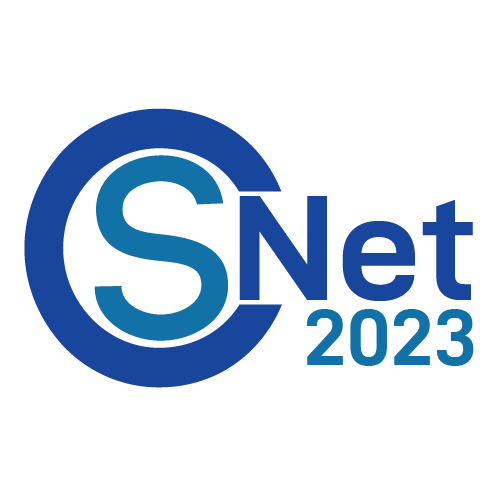CSNet 2023 Camera Ready Guidelines
If you have received a notification of acceptance email from the TPC co-chairs, please use these instructions to prepare your final camera-ready manuscript.
Please note that:
- IEEE reserves the right to exclude a paper from distribution after the conference (e.g., removal from IEEE Xplore) if the paper is not presented at the conference.
- Papers are reviewed on the basis that they do not contain plagiarized material and have not been submitted to any other conference at the same time (double submission). These matters are taken very seriously and the IEEE Communications Society will take action against any author who has been engaged in either practice. Please see the IEEE Web Page on Plagiarism and the IEEE Web Page on Double Submission.
Papers can be of three types (Full and Short, and Demo):
• Full papers up to a maximum of eight (8) printed pages (in Two-Column IEEE Conference Format), including text, figures, and references.
• Short papers up to five (5) pages (in Two-Column IEEE Conference Format), including text, figures, and references.
• Demo Papers up to three (3) pages (in Two-Column IEEE Conference Format), including text, figures, and references.
Please note that all papers accepted as short papers will be required to be reduced to 5-pages length. Also note that the Deadline for the camera-ready of Full and Short Papers is August 15, 2023. Please refer to EDAS for the exact deadline in your time zone to make sure that you abide by the stipulated deadline.
The deadline for Camera-Ready Demo papers will be announced later.
In order to submit the camera-ready manuscript, please follow the steps below:
Camera-Ready Manuscript
- All submissions must be written in English, with minimum of 10-point font and must follow the IEEE two-column page format, which is available at: https://www.ieee.org/conferences_events/conferences/publishing/templates.html
If you are using LaTeX, you need to use the following code as the first line in your LaTeX source file: \documentclass[10pt, conference]{IEEEtran} - Address all reviewers’ comments and revise your paper accordingly before submitting your camera-ready version. Also, make sure that all your figures are of high quality (preferably in .eps format) and their content is easily readable.
- Make sure also that your paper contains no headers, and no page numbers. This information will be added by the editors. Furthermore, thoroughly, proofread your source document to confirm that it will require no further revision.
- Make sure that the title/author list in EDAS is EXACTLY as in your final camera-ready paper. No change in authors is allowed once the paper has been accepted.
- Do not include any copyright notice in your document, this will be added automatically.
Then complete the Electronic copyright form for your paper on EDAS as follows:
IEEE e-copyright Form
Authors of accepted papers must complete the IEEE eCopyright Form. One copyright form is required for each accepted paper.
The electronic copyright form can be accessed via EDAS (http://edas.info) by selecting the “My Papers” tab, then selecting the paper title, and finally clicking on the “+” sign corresponding to the “copyright form” field. This will walk you through a series of steps. Make sure that the title/author list is EXACTLY as in your final camera-ready paper.
IEEE PDF eXpress
Next use IEEE PDF eXpress to check IEEE Xplore-compatibility, and generate your PDF compliant version, as detailed below. This is a mandatory step. Non-compliance might result in NOT having your paper published in the IEEE Xplore.
The final paper must be converted into PDF with settings compliant with the requirements of the IEEE Xplore digital library. To this purpose, the IEEE PDF eXpress web tool should be used. PDF files generated in a different way might not be IEEE Xplore-compliant and could be problematic. All PDFs to be included in IEEE Xplore should be validated through PDF eXpress for an assured Xplore compatibility.
The instructions to generate an IEEE Xplore-compatible PDF file using the IEEE PDF eXpress PLUS web tool are listed below*.
- Create an IEEE PDF eXpress plus account using the following conference ID.
- The first time you access IEEE PDF eXpress plus, please follow the link to “New Users – Click here”. The conference ID is 59123X
- Previous users of PDF eXpress need to follow the above steps, but should enter the same password that was used in previous conferences. Verify that your contact information is valid.
- After logging in, create a new title and enter the exact title of your paper. Then, upload the source files of your camera-ready paper for conversion (e.g. DOC, DOCX, TEX and so on). Alternatively, if your PDF is ready, you can also just check the compliance of your generated PDF file.
- After a few minutes, you will receive the IEEE-Xplore-compatible PDF version of your paper by e-mail.
- Upload to EDAS the PDF eXpress-passed camera-ready version of your paper. Do not upload any other version of the paper except that validated using PDF eXpress.
* In case you encounter any problems, you can access the Publications Support Center for IEEE PDF eXpress.








